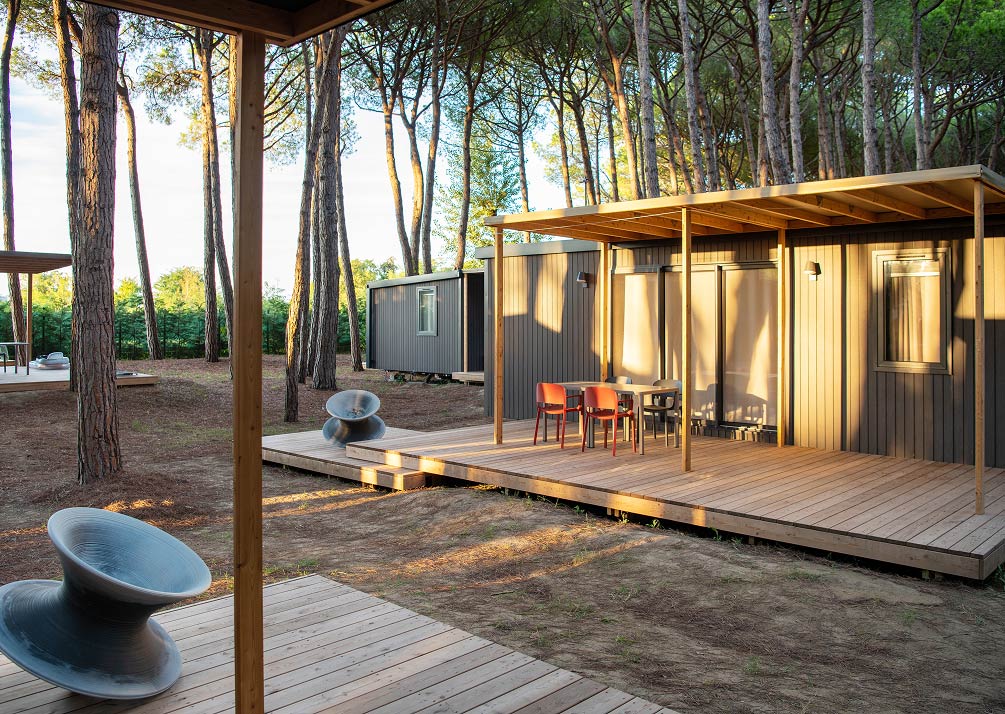Taniec wody, wiosła tnące fale, jaskrawe kolory odbijające się na Canal Grande: Historyczna Regata w Wenecji to jedno z najbardziej wyczekiwanych i spektakularnych wydarzeń weneckiej tradycji. Każdego roku, w pierwszą niedzielę września, miasto laguny przekształca się w wodne teatrum, gdzie historia, tradycja i rywalizacja łączą się, by stworzyć wyjątkowe widowisko.
Również w tym roku, 7 września, Wenecja ponownie uczci ten pradawny rytuał, celebrując głębokie związki Serenissimy z wodą — żywiołem, który ukształtował tożsamość tego niezwykłego miasta.
Niezbędna okazja dla gości Campingu Ca’Savio, którzy pragną wzbogacić swój pobyt o autentyczne i porywające doświadczenie, zanurzone w autentycznej kulturze weneckiej.
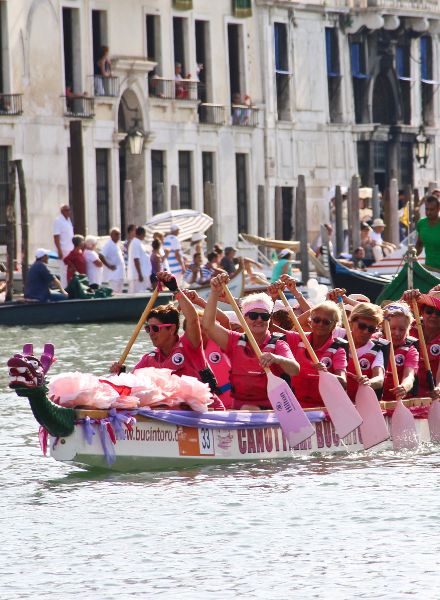
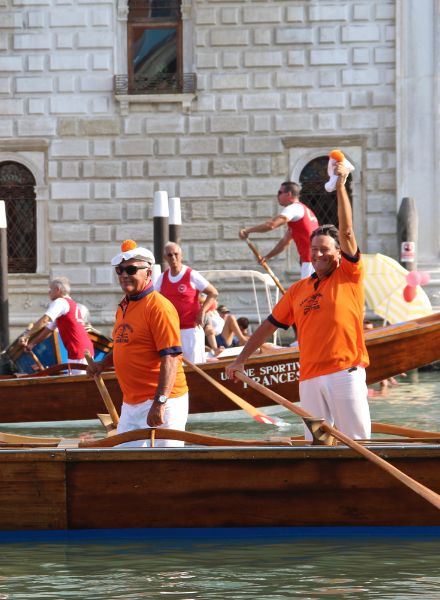
Regata Storica: wiekowe wydarzenie
Historyczna Regata ma swoje korzenie w odległej przeszłości Serenissimy i stanowi jedno z najstarszych i najbardziej rozpoznawalnych wydarzeń w mieście laguny. Już w XIII wieku kroniki weneckie odnotowywały wyścigi łodzi na Canal Grande, organizowane w celu uczczenia ważnych wydarzeń lub upamiętnienia znanych osób. Z biegiem wieków te nautyczne zawody stopniowo nabierały struktury i organizacji, rozwijając się od prostych demonstracji sprawności morskiej do prawdziwej rywalizacji.
Dzisiejsza forma wydarzenia sięga roku 1841, kiedy miasto Wenecja zdecydowało się zorganizować taki wyścig. W 1899 roku ówczesny burmistrz Wenecji, hrabia Filippo Grimani, oficjalnie nazwał go „Regata Storica”, konsolidując jego formę i zasady.
Struktura regaty
Dziś wydarzenie dzieli się na dwie główne części: paradę historyczną i zawody wioślarskie.
Parada — przed zawodami, z bogato zdobionymi łodziami i artystami w kostiumach historycznych — przywołuje splendor Republiki Weneckiej i jej dawne ceremonie publiczne. Ta Parada Wodna szczególnie przypomina przyjęcie Katarzyny Kornaro, królowej Cypru, która w 1489 r. zrzekła się tronu na rzecz Serenissimy.
Po paradzie odbywają się właściwe zawody, w których rywalizują różne kategorie — od młodzieży, przez kobiety, po mistrzów — na gondolach, łodziach niezwykle lekkich i szybkich. Zwycięzcy zachowują tradycyjne „Flagpoles”, kolorowe flagi, które stanowią upragnioną i prestiżową nagrodę w świecie weneckiego wioślarstwa.
Regata Storica to nie tylko zawody sportowe, ale także duży festyn ludowy, w którym uczestniczą mieszkańcy i turyści, by podtrzymać pamięć o chwalebnej przeszłości i potwierdzić głęboką więź między Wenecją a jej laguną.
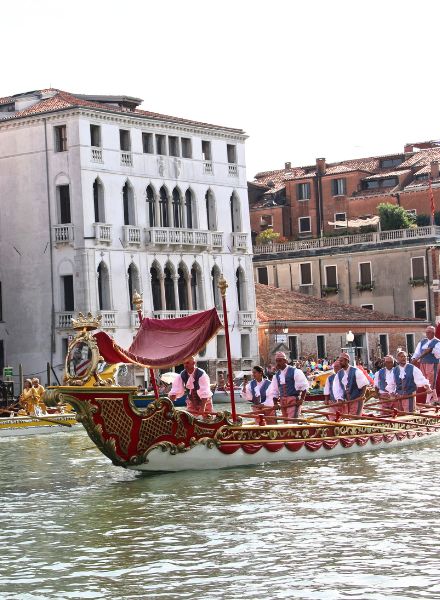
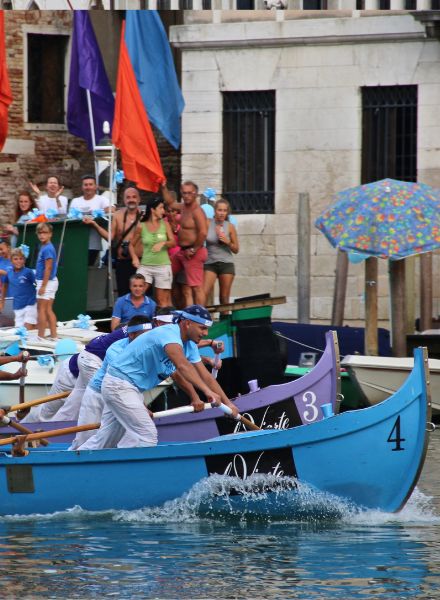
Ciekawe fakty o zawodach
Jednym z powodów, dla których ta rywalizacja jest tak wyjątkowa, jest używana technika wiosłowania: “weneckie wiosłowanie”. W przeciwieństwie do wioślarstwa olimpijskiego, w tej technice wioślarze stoją wyprostowani, patrzą do przodu i używają wioseł bez amboni. Ta technika zrodziła się z potrzeby zręcznego manewrowania w wąskich kanałach miasta oraz zachowania dobrej widoczności podczas pływania.
Ta pozycja pionowa, charakterystyczna dla weneckich łodzi, z czasem rozwinęła się w sztukę przekazywaną z pokolenia na pokolenie i stanowi wyraz głębokiego związku, jaki Wenecjanie mają ze swoją laguną.
Tradycyjne łodzie w wyścigu
Gondole
Gondole symbolizują mistrzostwo weneckiego stolarstwa okrętowego: wykonane z cenionego drewna i misternie ukształtowane, by dzięki opływowemu kształtowi osiągać znaczne prędkości.
To najbardziej znane łodzie w głównej regacie: są lżejsze, węższe i szybsze niż tradycyjne gondole i zostały specjalnie opracowane do rywalizacji.
Mascarete
Mascarete zawdzięczają swoją nazwę „Maschera” (wenecko: Maschereta), czyli wzmocnieniu na dziobie, które czyni je szczególnie wytrzymałymi. Pomimo lekkości, manewrowości i łatwości obsługi, są idealne do zawodów damskich, gdzie technika i koordynacja górują nad siłą.
Pupparini
Pupparini ze swoim charakterystycznym zwężającym się profilem zawdzięczają nazwę szczególnie bogato wykonanym rufom (po wenecku “puppa”). Łodzie te, które niegdyś służyły do szybkiego transportu osób i wartościowych ładunków, są dziś idealnym polem rywalizacji dla młodych wioślarzy wchodzących w świat wioślarstwa sportowego.
Caorline
Caorline z płaskim dnem i wysokimi burtami były „statkami towarowymi” laguny weneckiej, transportującymi masywne i ciężkie dobra. Dziś, w wersji regatowej, zachowują swą pierwotną solidność, ale są lżejsze i zoptymalizowane pod kątem prędkości. Wyścig Caorline to triumf współpracy, gdzie sześciu wioślarzy musi być perfekcyjnie skoordynowanych.
Bissone
Bissone to prawdziwe królowe parady historycznej: długie, kolorowe łodzie ozdobione gildowanymi rzeźbami i misternymi dekoracjami. Ich nazwa prawdopodobnie pochodzi od „biscia” (wąż), ze względu na wydłużony i zakrzywiony kształt. Na pokładzie artyści w kostiumach historycznych odtwarzają atmosferę renesansowej Wenecji, tworząc widowisko rzadkiego piękna, które poprzedza zawody.
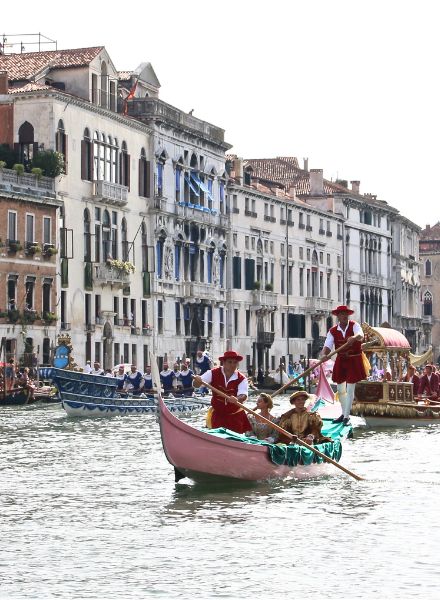
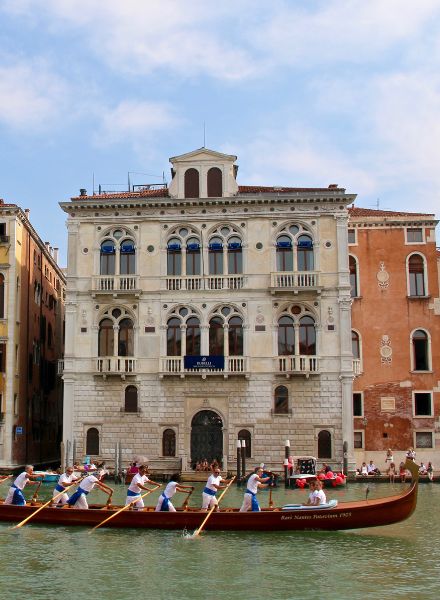
Jak przebiega historyczna Regata w Wenecji?
Historyczna regata rozgrywa się wzdłuż Canal Grande. Start następuje przy „Spaghetti” (napięty linowy przewód) przed Ogrodami Publicznymi Castello, w Basenie San Marco. Stąd łodzie przemierzają Canal Grande w całej długości, mijając Most Rialto, i kontynuują aż do stacji Santa Lucia.
Tu znajduje się „Palette”, słup w środku kanału, który służy jako punkt zwrotny. Wioślarze muszą okrążyć ją i powrócić wzdłuż Canal Grande, aż dotrą do linii mety przed Ca’ Foscari, gdzie znajduje się „Machina” — bogato zdobiona konstrukcja pływająca mieszcząca jury, z której wręczane są nagrody.
Ten odcinek o łącznej długości około 7 kilometrów wystawia na próbę wytrzymałość i umiejętności uczestników, którzy muszą zmierzyć się nie tylko z przeciwnikami, ale także z prądami i falami kanału, w środowisku wymagającym technologii i strategii.
Program Regata Storica 2025
W niedzielę 7 września Regata Storica di Venezia oferuje bogaty program wydarzeń, zapewniający rozrywkę przez cały dzień. Kulminacja zaczyna się od parady historycznej. Po południu odbywają się różne wyścigi wioślarskie, każdy z różnymi łodziami:
- Regata najmłodszych na Pupparini z dwoma wiosłami
- Regaty kobiet na Mascarete z dwoma wiosłami
- Regaty na Caorline z sześcioma wiosłami
- Regaty Mistrzów na gondolach z dwoma wiosłami — najbardziej oczekiwane
Każdy wyścig daje możliwość podziwiania nie tylko umiejętności wioślarzy, ale także urody tradycyjnych weneckich łodzi — prawdziwych klejnotów lokalnej kultury żeglarskiej.
Jaki jest najlepszy sposób na oglądanie Regata Storica?
Oglądanie Regata Storica to niezapomniane doświadczenie, ale by w pełni cieszyć się widowiskiem, ważne jest wybranie najlepszego miejsca. Oto niektóre opcje:
Z nabrzeży Canal Grande
Promenady nad wodą wzdłuż Canal Grande oferują darmowe miejsca do oglądania, ale warto przybyć wcześnie, by zająć miejsce tuż przy brzegu. Najbardziej pożądane lokalizacje to okolice Mostu Rialto i rejon Ca’ Foscari.
Z mostów
Mosty nad Canal Grande, zwłaszcza Most Accademia i Most Rialto, oferują znakomite panoramiczne widoki na trasę regaty. Również tu warto przyjść bardzo wcześnie, by zdobyć dobry punkt obserwacyjny.
Z prywatnej łodzi
Dla ekskluzywnego doświadczenia można wynająć prywatną łódź z sternikiem, z której można obserwować regatę z bliska i cieszyć się wyjątkową perspektywą.
Z tarasów i balkonów pałaców
Niektóre hotele i restauracje z widokiem na Canal Grande organizują specjalne wydarzenia na Regata Storica i oferują możliwość oglądania z tarasów lub panoramicznych balkonów. Choć droższa opcja, zapewnia komfort i uprzywilejowany widok.
Pływające trybuny
Na tę okazję ustawiane są pływające trybuny w strategicznych punktach trasy, z płatnymi miejscami, z których można wygodnie podziwiać widowisko.
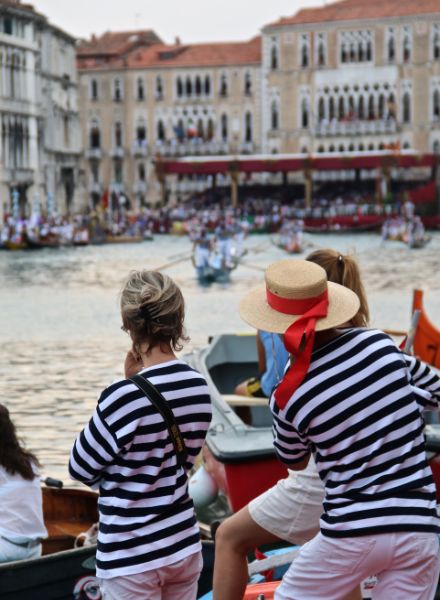
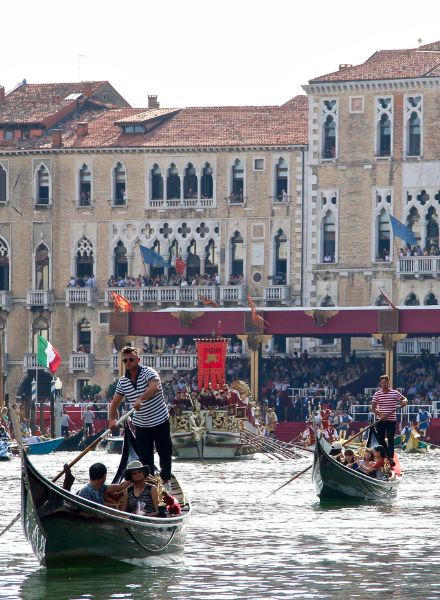
Niezależnie od wyboru, świąteczna i fascynująca atmosfera Regata Storica zapewnia pełne zanurzenie w najautentyczniejszej weneckiej kulturze. Dla gości Ca’Savio dzień przy Regata Storica to zatem wyjątkowe przeżycie, gdzie przeszłość i teraźniejszość spotykają się na wodach Wenecji.
Nie zaplanowałeś jeszcze wrześniowego urlopu? Skorzystaj z niskiego sezonu i zarezerwuj pobyt na kempingu Ca’Savio, zaledwie rzut kamieniem od Wenecji!

